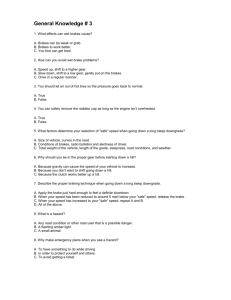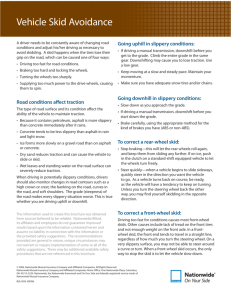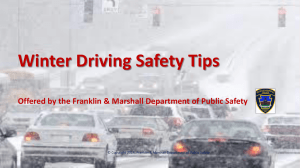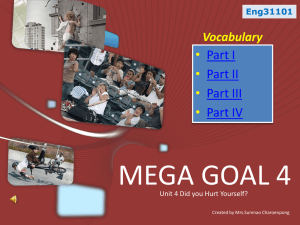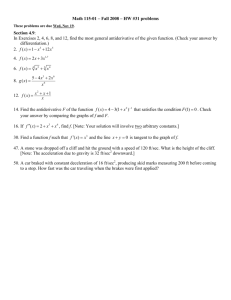Driving in Bad Road and Weather Conditions
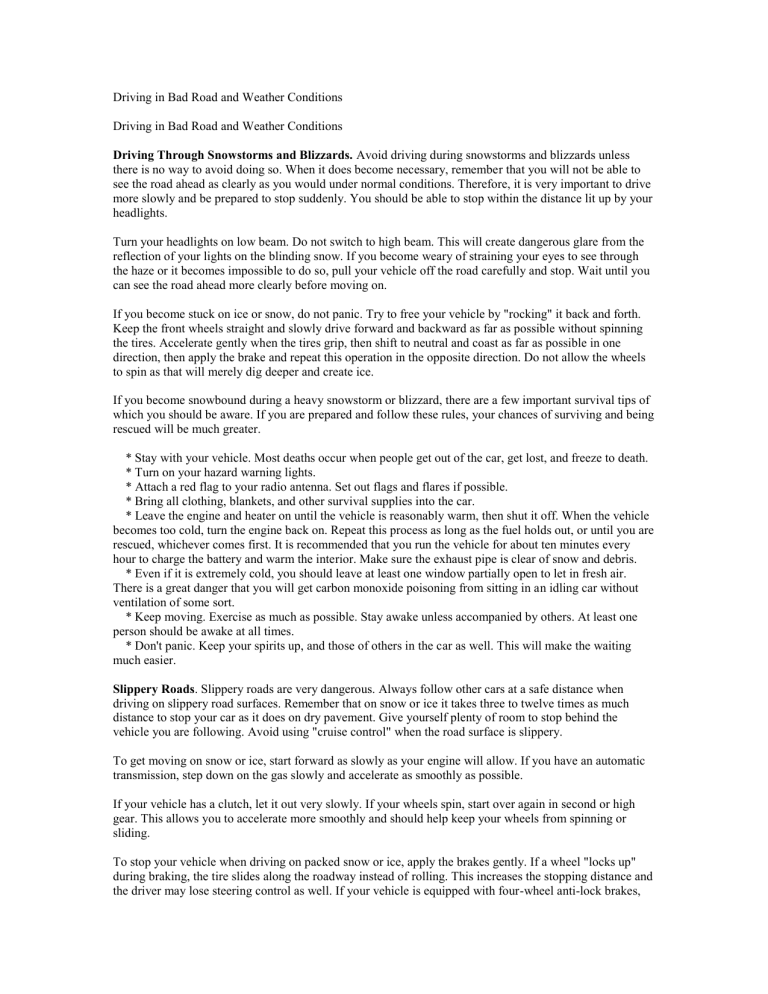
Driving in Bad Road and Weather Conditions
Driving in Bad Road and Weather Conditions
Driving Through Snowstorms and Blizzards.
Avoid driving during snowstorms and blizzards unless there is no way to avoid doing so. When it does become necessary, remember that you will not be able to see the road ahead as clearly as you would under normal conditions. Therefore, it is very important to drive more slowly and be prepared to stop suddenly. You should be able to stop within the distance lit up by your headlights.
Turn your headlights on low beam. Do not switch to high beam. This will create dangerous glare from the reflection of your lights on the blinding snow. If you become weary of straining your eyes to see through the haze or it becomes impossible to do so, pull your vehicle off the road carefully and stop. Wait until you can see the road ahead more clearly before moving on.
If you become stuck on ice or snow, do not panic. Try to free your vehicle by "rocking" it back and forth.
Keep the front wheels straight and slowly drive forward and backward as far as possible without spinning the tires. Accelerate gently when the tires grip, then shift to neutral and coast as far as possible in one direction, then apply the brake and repeat this operation in the opposite direction. Do not allow the wheels to spin as that will merely dig deeper and create ice.
If you become snowbound during a heavy snowstorm or blizzard, there are a few important survival tips of which you should be aware. If you are prepared and follow these rules, your chances of surviving and being rescued will be much greater.
* Stay with your vehicle. Most deaths occur when people get out of the car, get lost, and freeze to death.
* Turn on your hazard warning lights.
* Attach a red flag to your radio antenna. Set out flags and flares if possible.
* Bring all clothing, blankets, and other survival supplies into the car.
* Leave the engine and heater on until the vehicle is reasonably warm, then shut it off. When the vehicle becomes too cold, turn the engine back on. Repeat this process as long as the fuel holds out, or until you are rescued, whichever comes first. It is recommended that you run the vehicle for about ten minutes every hour to charge the battery and warm the interior. Make sure the exhaust pipe is clear of snow and debris.
* Even if it is extremely cold, you should leave at least one window partially open to let in fresh air.
There is a great danger that you will get carbon monoxide poisoning from sitting in an idling car without ventilation of some sort.
* Keep moving. Exercise as much as possible. Stay awake unless accompanied by others. At least one person should be awake at all times.
* Don't panic. Keep your spirits up, and those of others in the car as well. This will make the waiting much easier.
Slippery Roads . Slippery roads are very dangerous. Always follow other cars at a safe distance when driving on slippery road surfaces. Remember that on snow or ice it takes three to twelve times as much distance to stop your car as it does on dry pavement. Give yourself plenty of room to stop behind the vehicle you are following. Avoid using "cruise control" when the road surface is slippery.
To get moving on snow or ice, start forward as slowly as your engine will allow. If you have an automatic transmission, step down on the gas slowly and accelerate as smoothly as possible.
If your vehicle has a clutch, let it out very slowly. If your wheels spin, start over again in second or high gear. This allows you to accelerate more smoothly and should help keep your wheels from spinning or sliding.
To stop your vehicle when driving on packed snow or ice, apply the brakes gently. If a wheel "locks up" during braking, the tire slides along the roadway instead of rolling. This increases the stopping distance and the driver may lose steering control as well. If your vehicle is equipped with four-wheel anti-lock brakes,
do not let up on the brake pedal. See your owner's manual for more information on proper emergency braking techniques. For sudden stops in all other vehicles with conventional or rear-wheel anti-lock brakes only, "squeeze" your brakes -- don't slam down on them! Push your foot down on the brake slowly until you feel the wheels begin to lock up, let off the pedal, and then squeeze again. Repeat this procedure until the vehicle stops.
Skidding.
A vehicle starts to skid when its tires lose their grip on the road surface. When this happens to your vehicle your first instinct is to slam your foot down on the brakes. This is a big mistake. Applying the brakes quickly will only cause your vehicle to skid faster. It will also make you unable to steer the vehicle because your front wheels will lock. The main thing to remember in a skid is to keep calm and not overreact.
When your vehicle starts to skid the first thing you have to do is regain control. Keep your feet off the accelerator and brakes until you have regained the ability to steer the vehicle. Only then should you begin to apply the brakes - very carefully. Do not use them unless it is necessary.
Keeping your car under control means you must turn in the direction you want the front of the car to go.
Because you are already looking forward you have a definite guideline where you want to steer.
Even though this may seem simple to do, it still requires skill -- and must be done quickly to be effective. A car can reach a "point of no return" very suddenly in a skid. This means the back of the car is going to come around no matter how much you try to steer out of it. You should start to counter-steer as soon as you feel a skid. But don't counter-steer so sharply that you skid again in the other direction.
The signs that it is time for emergency action by the driver in skid situations are different for front-wheeldrive cars and rear-wheel-drive cars.
The first sign of control loss in a skid in a rear-wheel-drive car is usually a rear-wheel skid. The rear end of the car starts to slide sideways. It could start swinging at wide angles, either to the left or right.
In a front-wheel-drive car, usually the sign is a loss of steering ability. This is because the front wheels are both the drive wheels and the steering wheels.
Some owners of front-wheel-drive cars think they can come out of a skid by giving the car some gas and letting the front wheels "pull" the car straight. Driving experts say this works once in a while, but is not a good idea because it can make the problem worse.
When you start to skid, you want as much steering traction as possible. The best way to do this is to let off of the accelerator and brakes so all your traction can be used for steering.
Of course, it is best to avoid skidding at all. One way to stay in control is to use your brakes properly in winter weather. Not long ago, drivers were told to pump their brakes when they needed to stop on slippery surfaces. Pumping the brakes was supposed to keep them from locking, which causes loss of steering ability.
But pumping the brakes -- on snow or ice -- can make the wheels lock for a moment, causing a loss of steering. The rapid leg movements used in pumping the brakes can also keep you from noticing that they have locked.
Instead of pumping, driving experts recommend the "squeeze technique." This simply means you squeeze the brake pedal down until you feel the brakes are about to lock up, let off the pedal, then squeeze again.
Squeezing the brakes slows down the car quickly, while letting you feel if the brakes lock up. That way, you will keep your tires rolling, which is the key to steering.
This is not a technique that you will master instantly. Driving experts recommend that you practice braking in a safe area, like a parking lot, so you will develop a sense of when your brakes are about to lock. The
only time you should not use this method of braking is when your vehicle has four-wheel anti-lock brakes.
In that case it is best to step on the brake pedal and hold it down until you stop the vehicle.
Reacting to an emergency requires quick action, but it is important to avoid stepping too hard on the brakes. If you "stand" on them, you are likely to end up losing control and sliding into someone. By squeezing the brakes and keeping the wheels rolling, you might be able to steer around an object instead of hitting it. If you do panic and lock up the brakes, you can still regain control by backing off the brake pedal.
In many situations it is best to steer around trouble without trying to brake at all. As driving experts point out, if you do not have time to steer around something, you certainly will not have time to stop for it.
Remember the leading cause of death during winter storms is transportation accidents.
